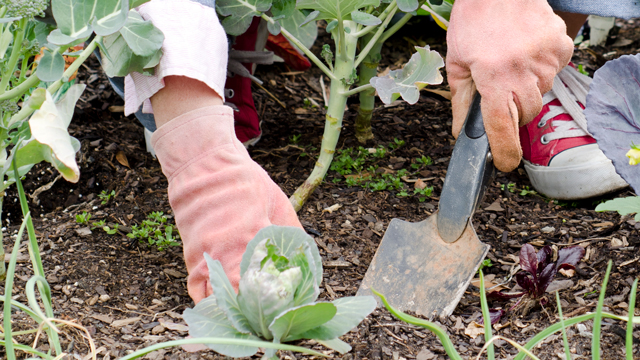During late fall, the gardening season is winding down and it’s time to attend to a few details. With a bit of maintenance now, your garden will pass through winter unscathed and emerge ready for another wonderful growing season. Let’s get started!
1. First, jot down a few notes about the successes and failures of this season. Tuck these notes in a folder or journal to read before making any plans for next year.
2. If you haven’t already – yes, this should have happened in September – look at your perennials and rearrange or remove plants as deemed necessary. The daylilies, iris, goldenrod, bee balm, asters, firecrackers, and other aggressive plants that outgrew their welcome should be thinned now. This kind of weeding is done to stop plants from going to seed and reduce their presence next season. (So the earlier the better!)
3. In the borders and beds, remove weeds that were missed earlier, then cut down and compost annual bedding plants that haven’t done well in chilly weather. Consider leaving the petunias and snapdragons, which will thrive in the off-season.
4. While working in the garden among the fading flowers and shriveling leaves, look out for white powdery growth signaling powdery mildew, or burgundy leaf spots – some with brown centers and some with yellow halos. For sanitary purposes, cut down and remove those perennials and rake up the debris for bagging and disposal. Don’t add this to the compost pile. Also, scan the plants for praying mantis egg cases. If discovered, cut away the section of stem with the egg case and carefully tuck it into a nearby evergreen. This beneficial insect should have a place in the garden come spring.
5. If at all possible, leave healthy ornamental grasses and perennials in the landscaping beds to give pollinators a place to winter. They also look beautiful! If you’re planting pansies and spring-blooming bulbs, cut away the declining plant growth to make room.
6. If you like, you can lightly mulch the beds to buffer the soil temperatures and retain moisture through the unpredictable winter months.
7. Secure climbing roses to a structure to prevent damage from the whipping wind. Hybrid tea and other modern roses should be cut by one third to reduce snow and ice load until they receive a hard-pruning in mid-February.
8. You may want to wrap marginally hardy plants (such as gardenias) in burlap, or tuck leaves and straw underneath them. You can also opt to save this particular treatment for periods of subfreezing temperatures this winter. (With erratic weather patterns, it’s difficult to predict when or if this step will be necessary.)
9. For evergreen bushes growing under house eaves, consider placing A-frames built out of plywood over them to deflect snow and ice that might slide off the roof. Wait until late winter to prune trees and bushes. Pruning now may trigger tender new growth that will be killed come the first frost.
10. In the vegetable garden, remove the tired plants of summer as the weather cools. October is the time to sow seeds of lettuce, radish, collards, kale, beets, and spinach. Areas not planted for the winter should be seeded with a cover crop such as red clover. At the very least, cover any bare soil with straw for protection from the winter wind.
11. Fall is a great time to sample and test the soil. After receiving the results from a local lab or Virginia Tech, add amendments per the lab’s instructions during the warmer periods of the winter before the next growing season begins.






